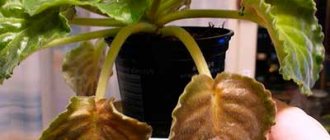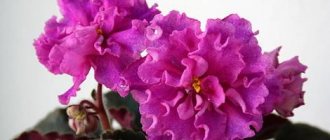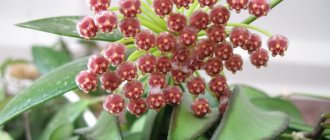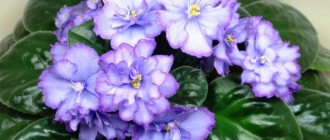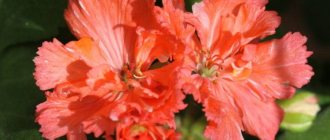Violets are loved not only by collectors, but also by ordinary flower growers. Almost all of them have at least several varieties of violets. One of my favorites is the Humako Inches variety.
The white and blue cap of flowers against the background of green foliage looks gentle and elegant . The long flowering period allows you to admire such beauty for a long time. Before you buy this violet, you must understand the peculiarities of its cultivation and the intricacies of its care. The photo and description of the Humaco Inches violet below will help you with this.
Violet variety Humako inches
This variety of Uzambara violets belongs to the Gesneriev family, the genus Saintpaulia hybrids.
Photos and descriptions of the Humako inches violet variety are presented below. This is a beautiful, showy plant with very large white flowers decorated with a bluish-blue wide center. The diameter of the cup is from six to eight centimeters. The leaves of the violet Humako inches are light green, round, collected in a large, even, neat rosette. It can be made more compact if the petioles are not allowed to grow in length. The description of the violet Humako inches (photos of rooting leaves are posted below) notes that it reproduces very easily and begins to bloom after eight months. It blooms luxuriantly, forming a thick hat. The flowers completely cover the rosette and last a very long time, even in the heat. This process continues for a long time in the Humako inches violet. Spent flower stalks are constantly replaced by new ones. All this makes this variety of violet very decorative and attractive for decorating rooms.
You will be interested in: How to grow aloe at home: breeding options, planting rules, recommendations for growing and care
Reproduction methods
Humako inches violet, like most of its indoor relatives, is propagated by leaf cuttings. For propagation, take a healthy mature leaf from the lower tier of the rosette, cut it at an angle, and treat this area with activated carbon. Root it in a dark glass container with boiled water, or by placing it in damp sphagnum moss. When roots appear on the cutting after one and a half to two months, it is planted in the soil. Some people prefer to place the cuttings directly into the soil, where rooting occurs.
Violets can be propagated by seeds, but this method is almost never used at home.
Possible problems during cultivation
Description of the 23 best varieties of tenacious violets, features of planting and care
As a rule, if you follow the rules for caring for Uzambara violets, there are no problems with their cultivation. Deterioration of leaves, general appearance, or lack of flowering may be caused by improper care. Sometimes problems arise as a result of pests and diseases.
Change in leaf condition
The most common problem with Saintpaulias is deterioration of the leaves. There may be several reasons for this:
- placement of pots too close (the leaves of neighboring flowers touch);
- excessive watering;
- incorrect landing;
- pest damage;
- root system disease;
- lack of light.
All these factors can cause the appearance of spots on the leaves or the development of rot in the cuttings.
Changing the condition of the leaves is a sign of disease
Important! Plants should be inspected regularly and appropriate measures should be taken at the first sign of deterioration.
Pests and diseases
All varieties of Saintpaulia, and especially varietals such as Humako inches, are susceptible to the following diseases: fusarium, late blight, powdery mildew, and various rots. The cause of the disease may be improper care or infection from another neighboring plant. Cyclamen mites and aphids are also dangerous.
At the first signs of the disease, measures should be taken and the necessary treatment should be carried out. It is also necessary to isolate the diseased flower from other plants until complete recovery. In especially severe cases, it is recommended to transplant into another pot and completely replace the soil.
Systemic insecticides are used against pests, which can easily be found in a flower shop.
Improper care
Growing Saintpaulias requires strict adherence to the rules for the care and maintenance of these flowers. They are very sensitive to temperature changes, drafts, and non-compliance with the watering schedule.
Any deviation from the flower care program will lead not only to a deterioration in its appearance and lack of flowering, but also to the death of the plant.
Saintpaulia, commonly known as violet, Humako inches is a wonderful representative of the Gesneriev family. This flower is quite unpretentious. By following simple care rules and providing optimal maintenance conditions, you can admire the flowering of this beautiful Saintpaulia for 8 months a year.
Diseases and pests
If the room where the violets are kept is too hot, they can be damaged by red spider mites. You can fight them by spraying the plant with systemic insecticides.
Violation of the temperature regime and waterlogging of the soil leads to the appearance of a disease such as black leg. The base of the stems turns black and thins, which entails weakening and death of the plant. In this case, it is necessary to completely replace the soil and disinfect it with Fundazol.
High soil and air humidity can lead to late blight affecting violets. The leaves become covered with brown spots, rot and fall off, as a result the plant may die. To prevent late blight, superphosphate should be added to the soil.
Thrips are dangerous pests of violets. They settle on the lower part of the leaves, and the larvae hatch in buds and flowers. Externally, this lesion looks as if the Humako inches violet is shedding pollen. To save the plant, all buds and flowers should be removed.
Root nematode is another dangerous enemy of violets. It attacks the roots of the plant. The disease can be recognized by the yellowing leaves of the plant. To save him, special potent drugs will be required. To avoid nematode infection, it is strictly forbidden to use ordinary soil on which cultivated plants grew to grow violets.
Despite the capricious nature and high requirements for living conditions, this variety of indoor flower is worth decorating your home with.
The violet will gratefully respond to the attention shown to it and will delight you with its abundant and lush flowering
Views: 19
How and when does it bloom
Peony Red Charm: description of the variety, features of planting and care
What a violet looks like - description of the plant
Uzambara violet Humaco inches has a very long flowering period. As a rule, it begins in March and lasts until the end of November. In rare cases, you can see flowering specimens even in winter.
An interesting fact is that there are two types of this plant, new and old, which differ in the shape of the petals on the flowers. A true representative of the variety is considered to be Saintpaulia with large simple petals, and the presence of slight waviness along the edge is considered a sign of an experimental subspecies. Both varieties can be found not only in private collections of lovers of Uzambara violets, but also on public sale.
The peculiarity of the experimental variety is wavy petals
Features of care during flowering
The most anticipated moment when growing Saintpaulias is the flowering period. To prolong it and provide the flower with optimal conditions at this time, it is worth considering several important points:
- you cannot move the pot with the plant to another place;
- watering should be carried out especially carefully, avoiding moisture on the flowers;
- it is necessary to regularly apply mineral fertilizers at intervals of 10-14 days;
- wilted flowers must be carefully removed.
Another point concerns young plants. Typically, Uzambara violet blooms at the age of 8 months. If the buds began to form earlier, it is better to remove them. This will allow the young plant to fully increase the vegetative mass and develop the root system.
Features of home care
The main conditions necessary for the normal growth and development of a plant are light, air, heat, water and nutrients in the soil. For Saintpaulia, especially important points are compliance with the technology and watering schedule, as well as choosing the optimal location for its placement.
The basic list of requirements and conditions for growing this plant includes several points.
Temperature The optimal temperature for growth is 20-23 degrees. They can tolerate a slight drop of 3-4 degrees. Lighting Lighting needs to be intense, daylight hours are long, but direct rays should be avoided. With a lack of light, Saintpaulia may not bloom, and the leaves may stretch upward. Watering Watering should be carried out in the pan, but the water should not stagnate in it. The difference between the temperature of water for irrigation and air by more than 5 degrees is unacceptable. Therefore, water for irrigation should only be used at room temperature. Spraying Saintpaulia leaves are not washed or sprayed.
Hairs on the surface of leaves have the ability to retain moisture - this leads to the development of rot. Humidity There are no special requirements for humidity, but it will be useful to place plants near vessels with water or trays with wet expanded clay. Soil For planting, use a ready-made soil mixture for Uzambara violets or mix 4 parts of deciduous soil and one part each of peat and sand yourself. Fertilizing It is recommended to apply complex mineral fertilizing at intervals of 12-15 days in the spring-summer period. It is permissible to apply cow manure diluted 1 to 10 with water, but care should be taken to avoid getting fertilizer on the leaves.
A tray with wet expanded clay increases humidity
Attention! For all Saintpaulias, the intensity of light and the length of daylight are very important. If there is a lack of natural light, additional artificial lighting should be installed
Description and features of Humako Inches violet
Origin
Peony sorbet: description of the variety, features of planting and care
This plant is another variation of the sensational Saintpaulia, however, in common parlance it is usually called violet. The name of this Saintpaulia comes from Germany, more precisely, from the German Baron Saint-Paul. It was he who first found these amazing flowers in the area around his residence.
A famous breeder, a friend of Saint-Paul, grew the first Saintpaulia from the seeds of a found plant, which became the ancestor of the currently existing species. Literally half a century later, there were already about a hundred varieties of this flower all over the Earth. There are already about three thousand of them in the modern world, but breeders don’t stop there.
As for Humako Inches, when translated into Russian the name is translated as Humako Inches. The first word is the name of a popular Dutch company specializing in violet breeding. The second word speaks about the size of the flower.
Description
In the regions of East Africa you can find this evergreen herbaceous plant growing up to 30 centimeters in height. In room conditions, the sizes are, of course, smaller.
The variety itself belongs to the Gesneriaceae family, to the genus of hybrid Saintpaulias. The plant is truly beautiful and graceful, with quite large flowers. Light green, oval-shaped leaves are collected in a rosette. They also have small villi and the leaves are pointed at the top.
Violet flowers are white with a blue center. They are collected in one brush, about five or six pieces each. Flower petals can be double or semi-double. In the first case there are many additional petals.
The fruits look like small capsules containing seeds. The plant propagates very simply and quickly.
The flowering process lasts a long time (from March to November), while the flowers bloom and become lush, covering the entire rosette. Old peduncles are replaced with new ones.
It is worth noting that in the summer, with extreme heat, the white tint becomes slightly less, while the concentration of blue color increases. At low temperatures, on the contrary, there is more white color.
Also, experienced breeders tend to believe that Humako Inches have two variations. The real plant has petals with smooth edges, while the other is a test plant, but is much more common in stores. The flowers of these plants are slightly smaller and have wavy edges.
Transfer
For violets to develop successfully, they require regular replanting. The planned procedure is carried out once every two years, when the soil in the pot is depleted. This is done in the spring. The new pot should not be much larger than the old one. For replanting, you can buy a special soil mixture for Saintpaulias or prepare it yourself, taking three parts of leaf soil, five parts of peat and one part of river sand. Drainage should take up almost half of the pot. Planned transplantation is usually carried out using the transshipment method, that is, with the ground.
An unscheduled procedure is carried out as needed when the soil in the pot becomes sour, due to a plant disease, etc. It is usually carried out with a complete or partial replacement of the soil. During each transplant, be sure to check the condition of the root system and separate the daughter rosettes, which can be used for vegetative propagation.
Origin of violet
Violet, or Saintpaulia, got its name in honor of the German Baron Saint-Paul, military commandant of the German district in East Africa. It was he who discovered these modest blue-violet flowers while walking in the vicinity of his residence. From the seeds of this plant, his friend, a famous florist, grew a flower called Saintpaulia violet, which became the progenitor of all species now available.
By the middle of the last century, there were already more than a hundred varieties of this plant in the world. Currently, several thousand varieties of violets are already known, and the selection process does not end there.
What does a Humaco Inches violet look like?
Humako Inches violet is the most common among indoor plant lovers. This is due to its extraordinary beauty: the combination of snow-white edges of the petals with a blue-violet core stands out brightly against the background of light green leaves. The rosette of leaves looks neat and compact, framing multiple flower stalks.
Amazing color of the Humaco Inches variety
Due to the small fibers located on all the leaves of the plant, as well as the velvety surface of the petals, the violet is covered with many sparkling reflections of the sun. This effect makes the flower even more decorative.
For your information! Violet variety Humaco belongs to the Gesneriev family. This is a hybrid variety developed by the Dutch floriculture company Humako. The company name appears in the name of each of their plants. But the word “inches” is translated as “inches,” which is an indication of the size of the varietal violet.
In nature, plants of this family can reach a height of 30 cm, but indoor varieties are much smaller in size.
About the history of appearance
The violet was first found in the mountains of East Africa, so the variety is often called Uzambara after the name of the mountains.
The scientific name of the violet genus is Saintpaulia. The word comes from the German language, derived from the name of Baron Saint-Paul, who first found the most beautiful flower. His breeder friend immediately bred the first domestic Saintpaulia, which in just a few decades won the love of flower growers all over the planet and became the ancestor of modern varieties of violets.
The color gradient may vary between specimens
Note! Violets were not named that way because of their purple color. The name of the flower comes from the word “viola” - that’s what it’s called in Latin.
In Polish, this word was modified to “fialek”, from there it passed into Russian as “violet” and became the basis for the name of the color.
Names of similar plants with which violets are often confused
There are many similar plants. This most often happens with:
- primrose. Perennial plant with lilac, pink and blue flowers;
- petunia. Bush plant with flowers of different shades;
- deikun. Loves slightly shaded places, does not tolerate drafts, and the flowers are about 4 cm in size;
- Streptocarpus. Its flowers look like umbrellas, and the plant grows up to 30 cm in height;
- gloxinia. It has purple, white and red leaves that feel like velvet to the touch. Gloxinia leaves are very similar to violet.
- garden viola. Requires careful care. The plant does not tolerate the scorching sun, so it is planted in the shade. The bush has a height of no more than 30 cm.
Violet Humako Flame
Description of Saintpaulia
The charming “flaming” variety of violet has a standard format. Its distinctive varietal quality is the neat, completely independent distribution of hatching leaves over the classic number of tiers of the bush.
The result is a compact, not too voluminous rosette with almost ideal silhouette contours.
Medium-sized leaves in the shape of a heart-shaped oval have a smooth surface with a quilted texture, teeth that are weakly expressed in the form of a soft wave along the contour, a uniform venation network with a main vein of increased size painted in a salad color, and a juicy, dark green color of the plates with a slight brownish tint, which appears in older leaves.
The violet forms the spatial volume of its caps from significant “pansy” flowers with a simple degree of filling with petals.
On top of the main white color in the central part of the corollas there are huge spots of varying intensity in shades of raspberry-cherry with watercolor-blurring borders.
A visual sensation is created of a flame blazing from the core of the flower.
Violet Humako Flame occasionally exhibits sporting qualities, forming evenly colored flowers of a crimson tone.
Features of growth and care
The variety does not cause unnecessary inconvenience to gardeners during its development, it is light and easy to grow and care for, and is distinguished by the following fundamental features:
- ideal and independent layout of a neat outlet;
- the ability to bloom magnificently, voluminously and often in caps;
- strong structure of peduncles, allowing to withstand the weight of flowering caps;
- increase in the size and beauty of flower caps with each wave of budding.
A varietal feature is a certain dependence of the violet color scheme on the temperature gradient:
- in extreme heat, the petals lose their color gradation and can become completely cherry-colored;
- in cool conditions, the color of the violet remains even.
Violet Humako Teardrops
Description
An exquisite standard with fantastic colors is no longer found in the manufacturer's catalogs. The violet was removed from the growing process due to its difficult adaptation in the collections of flower growers. But among Russian violet growers the variety is found quite often.
An independent violet conscientiously distributes its leaves within the compact boundaries of the tiers-floors, forming a neat rosette of an architectural mosaic configuration of a standard format, the dimensions of which are on the lower edge of the standard gradation. The bushes of this variety are more suitable for semi-miniature sizes.
The medium-sized leaves have a heart-shaped elongated shape with a distinct sharp tip, a smooth surface texture, neat, finely pointed teeth and even symmetry of the venation in the form of a dense network.
The general color background of the plates is represented by rich tones of emerald green, but in older leaves a slight darkening of the color is noticeable.
Some violet specimens exhibit a slight tuck of the tips of the leaves towards the flowerpot.
The flowers open in the form of simple “pansies” with significant outlines, their petals have an even configuration. The corollas themselves are painted with bright colors of a violet-cornflower blue palette, only the three lower petals are decorated with watercolor strokes in the form of white “tears” emerging from the center.
Features of growing in a room
NOTABLE! The variety turned out to be quite unpredictable when keeping indoor collections in a microclimate, so it was removed from the company’s catalogs.
But violet still showed several positive qualities:
- neatness and very compact forms of a self-forming bush;
- the incomparable decorativeness of brightly colored corollas;
- love for continuous flowering.
When there is insufficient lighting, the violet bends its leaves towards the flowerpot. Therefore, it is advisable to use an integrated mode - a combination of natural light and daylight spectrum lamps.
How and when does it bloom
Uzambara violet Humaco inches has a very long flowering period. As a rule, it begins in March and lasts until the end of November. In rare cases, you can see flowering specimens even in winter.
An interesting fact is that there are two types of this plant, new and old, which differ in the shape of the petals on the flowers. A true representative of the variety is considered to be Saintpaulia with large simple petals, and the presence of slight waviness along the edge is considered a sign of an experimental subspecies. Both varieties can be found not only in private collections of lovers of Uzambara violets, but also on public sale.
The peculiarity of the experimental variety is wavy petals
Features of care during flowering
The most anticipated moment when growing Saintpaulias is the flowering period. To prolong it and provide the flower with optimal conditions at this time, it is worth considering several important points:
- you cannot move the pot with the plant to another place;
- watering should be carried out especially carefully, avoiding moisture on the flowers;
- it is necessary to regularly apply mineral fertilizers at intervals of 10-14 days;
- wilted flowers must be carefully removed.
Another point concerns young plants. Typically, Uzambara violet blooms at the age of 8 months. If the buds began to form earlier, it is better to remove them. This will allow the young plant to fully increase the vegetative mass and develop the root system.
Watering
Violets need regular watering at the root. The soil in the pot should be moist, but not wet and stagnant. It is necessary to avoid getting water on the leaves to avoid their rotting and death of the entire plant. For this, the following watering methods are used:
- Immersing the pot in water.
- Watering from a tray.
- Wick moisturizing. This is when moisture enters a pot with a plant through a special device, the end of which is in a container of water, above which a flowerpot with a flower is located.
- Watering with a syringe.
To prevent the soil in the pot from becoming moldy, you can moisten the violet once or twice a month with water with the addition of phytosporin. For irrigation, use soft, lukewarm water, which must be left to stand for at least twelve hours. In winter, violets should be watered less often.
Possible problems in growing
There are several contraindications that relate to cultivation. The flower, by its appearance, will give clues regarding further actions. Sometimes there are problems with leaves, diseases and insects. But these are rare and isolated cases.
Features of cultivation
What do problems with leaves mean?
The appearance of a leaf can indicate many things:
- yellowing - excess moisture;
- drying of the tips - insufficient irrigation;
- folding - the need to fertilize the soil.
Important! Other signals from the leaves may be associated with an incorrectly selected planting site
Diseases
The common violet often succumbs to diseases associated with rotting of the root system. In addition, it can be affected by powdery mildew and gray rot. Tricolor is more resistant to any type of disease.
Pests
Bushes are rarely attacked by pests. Sometimes ants can live between the roots. The spider can spin a web between specimens - a common phenomenon for outdoor flowers.
Plant resistance to diseases and pests
Other problems
With the indoor version of the flower, problems may arise in terms of cultivation, breeding and care. Diseases often appear. Outdoor specimens are more resistant to weather conditions, harsh climates and external factors.
Triflower herb is considered medicinal and is often used in many areas of cosmetology. Previously, the plant was very popular among healers and physicians. Now many hybrids have been bred that are only superficially similar to the wild “ancestors”. Such specimens are resistant to weather conditions, diseases and pests. The aesthetic appearance captivates flower growers. The three-color color scheme is especially attractive.
How and when does it bloom
Uzambara violet Humaco inches has a very long flowering period. As a rule, it begins in March and lasts until the end of November. In rare cases, you can see flowering specimens even in winter.
An interesting fact is that there are two types of this plant, new and old, which differ in the shape of the petals on the flowers. A true representative of the variety is considered to be Saintpaulia with large simple petals, and the presence of slight waviness along the edge is considered a sign of an experimental subspecies. Both varieties can be found not only in private collections of lovers of Uzambara violets, but also on public sale.
The peculiarity of the experimental variety is wavy petals
Features of care during flowering
The most anticipated moment when growing Saintpaulias is the flowering period. To prolong it and provide the flower with optimal conditions at this time, it is worth considering several important points:
- you cannot move the pot with the plant to another place;
- watering should be carried out especially carefully, avoiding moisture on the flowers;
- it is necessary to regularly apply mineral fertilizers at intervals of 10-14 days;
- wilted flowers must be carefully removed.
Another point concerns young plants. Typically, Uzambara violet blooms at the age of 8 months. If the buds began to form earlier, it is better to remove them. This will allow the young plant to fully increase the vegetative mass and develop the root system.
How to care for Saintpaulia
Caring for the Humako inches violet, according to reviews from flower growers, like most Saintpaulias, consists of choosing the right location, observing the temperature regime, optimal watering, fertilizing and maintaining the required level of air humidity.
- The violet should be placed in well-lit places, but should not be exposed to direct sunlight. The plant must be protected from drafts and ensure that its leaves do not touch the window glass.
- There should only be one rosette per pot. This rule applies to all types of violets, except for hanging ones. Appearing lateral processes must be removed.
- For successful flowering, you should also pick off wilted and damaged parts of the plant. This must be done very carefully so as not to injure neighboring leaves and peduncles.
For abundant flowering, which usually occurs from March to November, violet needs good lighting - bright diffused light for at least ten hours a day, and preferably 14-16 hours. To extend this period, pots with plants are placed in winter on southern and western windows and artificial lighting is used. During the flowering period, they cannot be moved to another place. The container only needs to be constantly rotated so that the lighting occurs evenly.
Care
This Saintpaulia, like the others, requires proper care. The main thing in this matter is the right location and optimal humidity.
Selecting a location
.Choosing a place for Humako Inches is not so easy, however, this factor is the key to regular flowering. The place should be lit, but without direct sunlight. Excessive light causes rotting of leaves and petals. In addition, drafts and too high temperatures should not be allowed.
There should be no more than one rosette in one pot, and the lateral shoots must be removed. The same applies to injured and dried areas, however, all this must be removed carefully, without touching healthy areas.
To ensure good flowering, diffused light is required for at least 12 hours a day. In order to make this period longer, in winter the plant must be moved to the south or west side, while providing artificial lighting. However, directly during flowering, the pot with the plant should not be rearranged under any circumstances.
Humidity and temperature
The optimal temperature for this Saintpaulia is considered to be +18–24 degrees Celsius. In winter, it should not be less than 10 degrees, as the plant will simply die. If the temperature, on the contrary, is too high, the violet will not bloom.
Humidity should be at 50%, this can be ensured by placing the pot on a tray with wet pebbles. In addition, spray bottles should be avoided.
Watering
As for watering, it must be regular and at the root level. The soil should be moist, but not very wet. In order to avoid rotting and the appearance of pests, all moisture that gets on the leaves should be wiped off immediately. The following methods can be used for irrigation:
- immersing the pot in water;
- watering from a tray;
- humidification with a wick;
- using a syringe.
To prevent mold from appearing on the soil, it is recommended to moisten the plant with phytosporin water at least once a month.
Top dressing
In summer and spring, Humako Inches need to be regularly fertilized with mineral supplements. They should be applied at least 2 times a week according to the following scheme: 2 grams per 1 liter of water.
Shortly before the budding begins, mineral complexes and fertilizers should be used in large quantities in order to increase the number of buds. To ensure the necessary flowering, fertilizers should be half as much.
Transfer
Another important detail for successful plant growth is replanting. It needs to be done about twice in one year, when the soil in the pot becomes depleted. The best time for this is spring.
The pot should be the same size as the old one, and the soil should be suitable for Saintpaulias. There must be drainage - it should occupy about half of the pot.
If the transplant is planned, then it must be carried out using the transshipment method. In case of unscheduled work (soil acidification or plant disease), complete or partial soil replacement is used
It is very important not to forget to check the condition of the roots and separate the daughter parts of the violet necessary for propagation
Reproduction
This violet is most commonly propagated by leaf cuttings. It is necessary to take a healthy and mature leaf from the very bottom of the plant, treating this area with charcoal after removal. Then a dark glass container with boiled water is prepared, and the cutting is placed there. Just a few weeks later, with the appearance of the first roots, the violet can be safely moved into a pot with soil.
There is also a method of propagation by seeds, but it is used much less frequently.
You will learn how to choose high-quality Humako Inches violets in the store and not make a mistake in the following video.
Transplantation after purchase and during reproduction
The replanting procedure should be carried out twice a year, since due to abundant flowering the soil is very quickly depleted. To do this, select a pot of the same size and prepare the soil for the Saintpaulias. The drainage layer should occupy at least 1/3 of the container.
Planned transplantation is carried out using the transshipment method. If the procedure is urgent due to acidification of the soil or the appearance of a disease, then the soil should be completely replaced, including the one located between the roots. At the same time, the entire root system is carefully checked and the daughter rosettes are separated for subsequent propagation.
Transplanting violets
Violet, description and photo Humako Inches (Humako)
Saintpaulia varieties of foreign breeders “H” (Humako).
Humako Inches (Humako).
. (Inch).
White flower with a wide blue center.
Light green, smooth, rounded foliage. The leaf blades are very large. Standard. The socket is smooth and quite neat. The rosette is quite large, but can be grown compact if it is not allowed to grow long petioles.
A very spectacular variety with huge flowers. Large flowers 6-8 cm in size. All flowers are almost the same size. In hot weather, the flower appears blue.
From the first flowering it blooms immediately with a cap. Flowers completely cover the rosette. Flowers last a very long time, even in hot weather. Flowering is long-lasting, flower stalks constantly appear, replacing those that have already faded.
Propagates easily, grows quickly, blooms after 8 months.
There are two “variants” circulating among collectors, or rather two different plants with the same name. Real Humako Inches - with a smooth edge of the petals. The second variety was a test variety, no name, similar to Humako Inches, but the flowers are smaller and the petals have a wavy edge. It was not put into production (as it does not tolerate transport on an industrial scale), but spread among collectors. They suggest calling it Humako Inches 2, Humako Inches No name, Saintpaulia (Humako).
Do you know that…?
Many varieties fade in summer and there is less white if this color is present in the flower. Some are darkened, while others lose part of the color scheme. Darkening of color in summer is a fairly common occurrence in the violet world. At low temperatures, violets lighten. The same variety can bloom differently on your windowsill and on your shelf, in summer and winter. The same applies to green ruffles. The law of low temperatures works here - the lower the temperature, the more expressive and wider the green ruffle.
Before you buy the violets listed below, carefully read the forums about their behavior on the windowsill. Many of them are very beautiful flowers. However, these can be large rosettes with large and fragile leaves, with leaves rising up or hugging the pot, forming many stepsons that interfere with the formation of a neat rosette, pulling the stem up and growing into a Christmas tree, bending the trunk, rare flowering with long breaks, fallen flowers or they last little and quickly wither, very long and recumbent peduncles, the color of the flower fades quickly, they do not like bright lighting on the windowsill, they are afraid of the slightest drying out or waterlogging, a large percentage of them go into sports or darken the flower.
Are they suitable for your window sill and the conditions that you can create for them? You will look at the flowers for several months, and the rosette will always be in front of your eyes. There are many beautiful flowers, there are much fewer beautiful and neat rosettes, look first at the rosette! Search and you may find a dozen violets with the same flower color if you are not interested in the smallest details as a collector.
• — Happy Returns (Volkmann); • — Harbor Blue (Weber); • — Harmony's Frilly Dealy (Harmony's Greenhouse). • — Hood Wink (Dates). • — Hot Summer Day (Stork); • — Huron (Eyerdom);
Varietal features
Many violets tend to swim when the temperature rises. If there is white in their color, it becomes less in the heat. This happens quite often. At low temperatures, plants lighten. All this applies to the Humako inches violet, whose flowers become more blue in the heat.
Collectors recognize two different plants called Humako inches. The true Humako inches violet has petals with smooth edges. The second known variety is a test variety. It was not put into production due to the fact that it turned out to be impossible to transport plants on an industrial scale. But they have become quite popular among amateur gardeners. Their flowers are not so large, but have wavy edges. This species is called Humako inches-2, or Humako inches No name.
Botanical description of violet
The homeland of Saintpaulia is the Uzambar and Ulugur mountains in East Africa, so it is also called by the name of these “giants”. Under natural conditions, this evergreen herbaceous perennial grows up to thirty centimeters.
The height of indoor violets is much less. Its oval leaves are collected in a rosette. The leaves are quite fleshy, covered with villi and slightly pointed at the top. The color of the leaf blades is green or spotted. Violet flowers consist of five elements collected in a brush.
Based on the type of petals, Saintpaulias are divided into double and semi-double. The former have many additional petals.
The fruits look like capsules containing numerous small seeds.
What does a Humaco Inches violet look like?
Humako Inches violet is the most common among indoor plant lovers. This is due to its extraordinary beauty: the combination of snow-white edges of the petals with a blue-violet core stands out brightly against the background of light green leaves. The rosette of leaves looks neat and compact, framing multiple flower stalks.
Amazing color of the Humaco Inches variety
Due to the small fibers located on all the leaves of the plant, as well as the velvety surface of the petals, the violet is covered with many sparkling reflections of the sun. This effect makes the flower even more decorative.
For your information! Violet variety Humaco belongs to the Gesneriev family. This is a hybrid variety developed by the Dutch floriculture company Humako. The company name appears in the name of each of their plants. But the word “inches” is translated as “inches,” which is an indication of the size of the varietal violet.
In nature, plants of this family can reach a height of 30 cm, but indoor varieties are much smaller in size.
